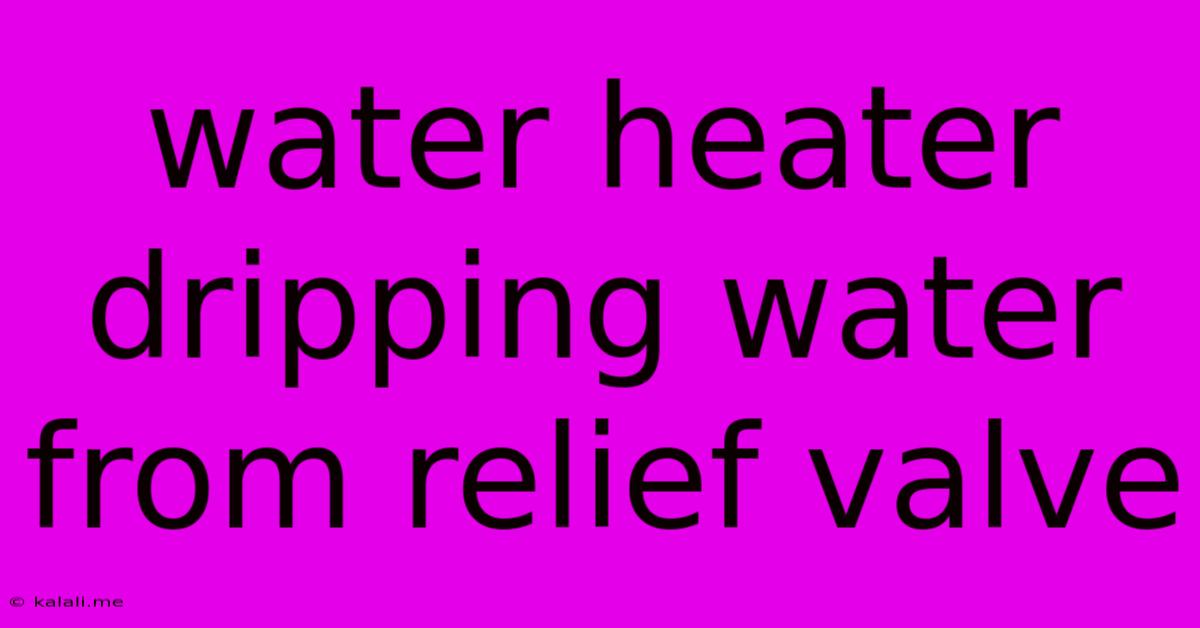Water Heater Dripping Water From Relief Valve
Kalali
May 20, 2025 · 4 min read

Table of Contents
Water Heater Dripping From Relief Valve: Causes and Solutions
A dripping water heater relief valve is a common problem that can signal a more serious issue with your water heating system. Ignoring this drip can lead to water damage, wasted energy, and even more costly repairs down the line. This article will explore the common causes of this problem and guide you through the troubleshooting and repair process. Understanding why your water heater is dripping is crucial for preventing further damage and ensuring your home's safety.
Understanding the Relief Valve
The temperature and pressure relief valve (T&P valve) is a critical safety device on your water heater. Its job is to release excess pressure and prevent dangerous explosions if the water inside gets too hot. A small drip is sometimes normal, but a consistent drip or stream indicates a problem that needs immediate attention.
Common Causes of a Dripping Water Heater Relief Valve:
There are several reasons why your water heater's relief valve might be dripping. Let's explore the most frequent culprits:
1. Excess Pressure:
- Overheating: A faulty thermostat or heating element can cause the water to overheat, leading to increased pressure and triggering the relief valve. Check your thermostat setting and consider having a professional inspect your heating elements.
- Sediment Buildup: Over time, sediment can build up at the bottom of your water heater tank, reducing its effective capacity. This can lead to increased pressure when the water is heated. Regular flushing is essential to prevent this.
- Expansion Tank Issues (if applicable): Some water heaters use expansion tanks to manage pressure fluctuations. A faulty or undersized expansion tank can cause excess pressure, leading to the relief valve dripping.
2. Faulty Relief Valve:
- Worn-out Valve: The valve itself might be worn out or damaged, allowing water to leak even under normal pressure. This is a common occurrence after years of use.
- Mineral Buildup: Mineral deposits can clog the valve, interfering with its ability to seal properly. This can result in a constant drip.
- Internal Valve Damage: Sometimes, internal components of the valve can break down, leading to leakage.
3. Other Potential Issues:
- Leaks Elsewhere in the System: A leak in another part of your water heating system, such as a pipe or fitting, might increase the overall pressure within the system, forcing the relief valve to release water.
- Incorrect Installation: In rare cases, an incorrectly installed water heater or relief valve can lead to pressure issues.
Troubleshooting and Repairing a Dripping Relief Valve:
Before attempting any repairs, turn off the power and water supply to your water heater. Safety should always be the top priority.
- Check for Excess Pressure: Use a pressure gauge to check the pressure inside the water heater tank. If it's significantly higher than the manufacturer's recommended pressure (typically 50 PSI), you need to address the underlying cause of the excess pressure (see causes mentioned above).
- Inspect the Relief Valve: Carefully examine the valve for any visible signs of damage, corrosion, or mineral buildup. A simple visual inspection can often reveal the problem.
- Try to Clean the Valve: If mineral buildup is the culprit, try carefully cleaning the valve with a wire brush or other appropriate tools. Be cautious not to damage the valve further.
- Replace the Relief Valve: If cleaning doesn't resolve the issue, or if you suspect the valve is damaged, replacement is the best course of action. This is relatively simple DIY repair for most homeowners. Remember to always purchase a valve that meets the specifications of your water heater.
- Address Underlying Issues: If you find another underlying cause (e.g., overheating, leaking pipe), address this issue before reinstalling the relief valve. Ignoring the root cause will likely lead to the problem recurring.
When to Call a Professional:
If you're uncomfortable working with plumbing or electricity, or if you're unable to identify and fix the problem after trying these steps, it's best to call a qualified plumber. A professional can diagnose the problem accurately and perform the necessary repairs safely and effectively.
By understanding the potential causes and employing the troubleshooting steps outlined above, you can effectively address a dripping water heater relief valve and prevent more serious problems down the line. Remember, a functioning relief valve is crucial for the safety and longevity of your water heater.
Latest Posts
Latest Posts
-
How To Get Better Water Pressure In Shower
May 21, 2025
-
How To Remove Painters Tape Residue
May 21, 2025
-
Should There Be A Space Between Number And Unit
May 21, 2025
-
Lego Harry Potter 1 4 Codes
May 21, 2025
-
Kings Cross To Euston Train Station
May 21, 2025
Related Post
Thank you for visiting our website which covers about Water Heater Dripping Water From Relief Valve . We hope the information provided has been useful to you. Feel free to contact us if you have any questions or need further assistance. See you next time and don't miss to bookmark.